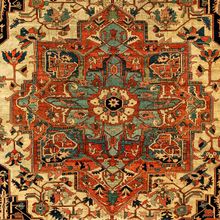Heriz Rug
| Heriz Rug | |
|---|---|
 Design of Heriz Rug (Rugman) | |
| General information | |
| Name | Heriz Rug |
| Original name | قالی هریس |
| Alternative name(s) | Heriz Carpet (Serapi Rug) |
| Origin | |
| Category | Village |
| Technical information | |
| Common designs | Lachak Toranj, Geometric |
| Common colors | Red, Brown, Green, Navy Blue, Pink, Blue, Ivory |
| Dyeing method | Natural, Synthetic |
| Pile material | Wool |
| Foundation material | Cotton |
| Knot type | Symmetrical (Turkish) |
Heriz Rug originate from Heriz, located in the Province of Azerbaijan. Heriz is a very important production center of Persian carpets. Hand woven by the Turkish inhabitants of Heriz, the creation of Persian carpets is their primary source of income and this time honored craft is passed down from generation to generation. The skilled artisans still use basically the same technique as that of the Mongols who invaded the region in the 13th century. Heriz rugs are the most sought after of the tribal rugs. Antique Heriz Persian carpets called Serapi (woven before 1900) are extremely valuable and highly collectable. Most weavers use the Turkish double knot, while the KPSI (knots per square inch) will vary depending upon the quality of the carpet. Heriz Persian carpets from the town's workshops are of better quality than those from the remote mountain villages. The silk Persian carpets are exceptionally finely knotted and are both very rare and absolutely exquisite.
History
Materials
Foundation and Pile
Techniques and structures
Color and dyeing
Motifs and Designs
Weaving techniques
See also
References
Bibliography
Abraham Levi Moheban, (2015), The Encyclopedia of Antique Carpets: Twenty-Five Centuries of Weaving, NewYork: Princeton Architectural Press.